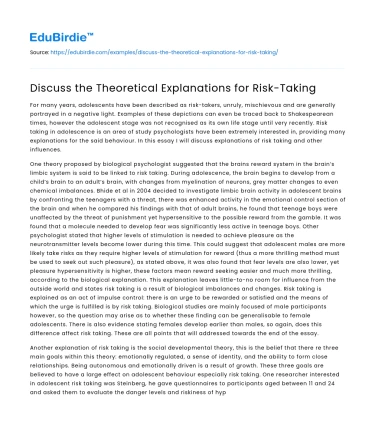For many years, adolescents have been described as risk-takers, unruly, mischievous and are generally portrayed in a negative light. Examples of these depictions can even be traced back to Shakespearean times, however the adolescent stage was not recognised as its own life stage until very recently. Risk taking in adolescence is an area of study psychologists have been extremely interested in, providing many explanations for the said behaviour. In this essay I will discuss explanations of risk taking and other influences.
One theory proposed by biological psychologist suggested that the brains reward system in the brain’s limbic system is said to be linked to risk taking. During adolescence, the brain begins to develop from a child’s brain to an adult’s brain, with changes from myelination of neurons, grey matter changes to even chemical imbalances. Bhide et al in 2004 decided to investigate limbic brain activity in adolescent brains by confronting the teenagers with a threat, there was enhanced activity in the emotional control section of the brain and when he compared his findings with that of adult brains, he found that teenage boys were unaffected by the threat of punishment yet hypersensitive to the possible reward from the gamble. It was found that a molecule needed to develop fear was significantly less active in teenage boys. Other psychologist stated that higher levels of stimulation is needed to achieve pleasure as the neurotransmitter levels become lower during this time. This could suggest that adolescent males are more likely take risks as they require higher levels of stimulation for reward (thus a more thrilling method must be used to seek out such pleasure), as stated above, it was also found that fear levels are also lower, yet pleasure hypersensitivity is higher, these factors mean reward seeking easier and much more thrilling, according to the biological explanation. This explanation leaves little-to-no room for influence from the outside world and states risk taking is a result of biological imbalances and changes. Risk taking is explained as an act of impulse control: there is an urge to be rewarded or satisfied and the means of which the urge is fulfilled is by risk taking. Biological studies are mainly focused of male participants however, so the question may arise as to whether these finding can be generalisable to female adolescents. There is also evidence stating females develop earlier than males, so again, does this difference affect risk taking. These are all points that will addressed towards the end of the essay.
Another explanation of risk taking is the social developmental theory, this is the belief that there re three main goals within this theory: emotionally regulated, a sense of identity, and the ability to form close relationships. Being autonomous and emotionally driven is a result of growth. These three goals are believed to have a large effect on adolescent behaviour especially risk taking. One researcher interested in adolescent risk taking was Steinberg, he gave questionnaires to participants aged between 11 and 24 and asked them to evaluate the danger levels and riskiness of hypothetical scenarios. He found that 16-year-old behave like adults however 15-year-olds were more likely to take risks. This study faced criticism from other psychologist and Steinberg himself began to question the methodology as it lacks ecological validity. In real life situations there is a lot more legitimate excitement and reactions, whether that be caused by chemical reactions or other factors. When studying risk-taking, psychologist could not control for emotional arousal as that was argued to be a factor of risk taking, therefore emotional arousal became a measured factor. Steinberg presented 70 male participants (14 adolescents, 19 youths and 37 adults) with a video game called ‘chicken’ that essentially tested their risk-taking skills (the readiness to stop the car at a red light, nearest to an upcoming wall in reward for point for stopping closest or no points at all for crashing the car). The groups played in 2 conditions: alone (emotionally cool) and in a group (emotionally hot), and their results were recorded. In “cool” situations, adolescent and adults took risks at the same rate, however in “hot” situations, adolescents took twice the risks as adults (who didn’t change based on condition). Steinberg concluded that adolescents took risks in high emotionally aroused situations because “they gave more weight to the payoff”.
The social developmental theory concluded that environment influenced emotional arousal thus causing adolescents to take risks. “Emotional arousal” is defined as heightened psychological emotions e.g anger, fear etc. with this definition, the adaptation Steinberg’s study can be used to explain the biological approach: the addition of external factors (presence of friends), heightens emotion (controlled by the limbic system which is already going through changes) affect the adolescent’s decision making and encourages risk taking. Further research was done to investigate why risk-taking is so prevalent in adolescents and it was found that many factors and experiences shaped the decision-making process. Researchers from UCL (2018) concluded (through longitudinal studies of 11726 families in the UK) that although risk taking is common among adolescents, the extent and frequency of risky behaviours varied amongst gender, social ranking, areas of residence, ethnicity, economic ranking and even factors such as sexual orientations had differences. For example, 6.1% of adolescents had tried drugs in Scotland compared to 2.8% in Northern Ireland. It was also recorded that participation in risky activities was also age dependant, (21% of 14-year-olds having dried drinking or smoking with only 3.5% 11-year-olds). These finding suggest that risk taking is influenced by other interactions and the outside world and is not just limited to biological causes.
In each explanation, there is an expectation of risk-taking behaviour in adolescents, however research shows that 79% of adolescents did not partake in substance use by 14-years-old. To fully understand influences to adolescent risk taking, more research will be needed.






 Stuck on your essay?
Stuck on your essay?

